Do you guys want to see where Disney & Co. get their inspiration and their decoration ideas from? Then follow me on a day trip to the picturesque town of San Cristobal de la Laguna – mostly just referred to as La Laguna – from where we’ll take the bus uphill to the enchanted forests of Anaga. Quick, call Snow White, and then it’s hi ho hi ho off to Anaga we go!

- Here Comes The Rain Again
- Fairy Tales in the Making
- Tradition And Prosperity
- Tour of the Historic Center of La Laguna
- Plaza de San Cristóbal
- Convento de Santo Domingo and Iglesia de Santo Domingo de Guzmán
- Plaza del Adelantado
- Casa del Santo Padre Anchieta
- Antiguo Colegio de Las Dominicas
- Palacio de Nava y Grimón
- Convento de Santa Catalina
- Casa de Los Corregidores
- Casa De La Alhóndiga
- Casa Alvarado Bracamonte
- Casa Van Den Heede
- Casa Montañés
- Casa Lercaro
- Real Sociedad Económica de Amigos del País de Tenerife
- Palacio Salazar
- Casa Museo Cayetano Gómez Felipe
- Iglesia de la Inmaculada Concepción de la Virgen María
- Teatro Leal
- Iglesia Catedral Nuestra Señora de los Remedios
- Urban Art in La Laguna
- Anaga Natural Reserve – A Visit To An Enchanted Forest
- How to Get to San Cristobal de La Laguna
- How to Get to Anaga Natural Reserve
- Where to Stay
- Well-Organized Activities
- Map
- Pinnable Pictures
Here Comes The Rain Again
I’ve described in my post on Santa Cruz de Tenerife the drastic weather change I had to endure as I landed in Tenerife. Coming from sunny and dry Fuerteventura, Tenerife welcomed me with cold temperatures, grey skies, and occasional drizzles. Just what I desired…not.

But just like you make lemonade when faith supplies you with citrus fruits, you should make the best of whatever weather the skies throw at you – especially when travelling. Hence, I put on the down windbreaker, a piece of clothing I had almost forgotten I had brought with me. I tied my hiking boots and was ready for yet another day trip.
When in Tenerife, there are certain places you supposedly need to visit, and San Cristóbal de la Laguna is very high on that list. And although I had to visit the town under quite unfortunate conditions, I can only agree. The famous historic center is beautiful – you can see that in my pictures between those stupid clouds. But since the oldest university of the Canary Islands is located in La Laguna, the city also has a young and dynamic vibe to it. I discovered some truly powerful street art by pure incident. Only later did I learn that the city actually installed two official programs promoting urban art.
I’m introducing this and all the historic classics in this post – besides an amazing detour to the Natural Reserve of Anaga – but now let’s first dive into the city’s glorious past.
Fairy Tales in the Making
In its present form, the historic center emerged by the end of the 16th century. Around that time, the city’s population grew rapidly. This was also because a law obliged landowners to live in the city if they did not want to lose their grounds.
La Laguna began to lose its importance as La Orotava obtained municipal rights in 1648. Up until this point, the Cabildo, hence, La Laguna’s city council, basically functioned as the island’s government. Since the 17th century, however, population growth stagnated drastically which also stopped the building boom.
Tradition And Prosperity
While the city’s economic and political insignificance continued into the following century, art and culture flourished. In the 18th century, La Laguna was the city of writers and artists, thriving under the patronage of noble families. Also, the first university in the Canary Islands was founded right here. To this day, La Laguna is an important university town.

The cultivation of sugar cane and the production of wine were important for La Laguna’s economy and so became the production of silk. Since the Canaries were on the trade route between Asia and the Americas, mulberry trees and the mulberry silk moths bred in China were introduced to the islands. On La Palma, you can visit the silk museum and learn more about the tradition of silk-making in the Canaries.
Nevertheless, in the 19th century, the city’s economic and political importance declined in favor of the city of Santa Cruz.
On the occasion of the city’s 500th anniversary, many historic buildings were renovated in 1999. The same year, UNESCO listed San Cristobal de la Laguna as a World Heritage Site. Obviously, this increased the city’s significance as a tourist magnet, albeit most visitors are coming just on a day trip.
Tour of the Historic Center of La Laguna
Since I had begun my tour of La Laguna with some mural hunting, I reached the historic center from a different spot than most visitors do. This is good because the first places I’m introducing are missing in most guides.

Obviously, you can just wander around the historic center of La Laguna, looking at the colorfully painted façade, the artfully carved balconies, the exquisite windows, and doors and you’ll have a great day. But sometimes, a bit of context helps to cherish beauty even more. That’s the reason why I’m supplying you with just a pinch of history and letting you take a quick imaginary look behind those splendid façades.
As always, I arrived by public bus which means I came from the rather dreary area around the Intercambiador, the city’s main bus hub. From there, I walked down Avenida Trinidad to Calle Barcelona and finally reached Plaza de San Cristóbal. This square lost its significance over the centuries, yet interesting and picturesque buildings are surrounding it to this date.
Plaza de San Cristóbal
Although the unusually long Plaza de San Cristóbal is an important spot with many shops and restaurants around, it is pretty much neglected by visitors. In fact, besides some lovely old houses, the most interesting building is the hermitage of San Cristóbal on the southwestern side of the square. After all, he’s the city’s Patron Saint.
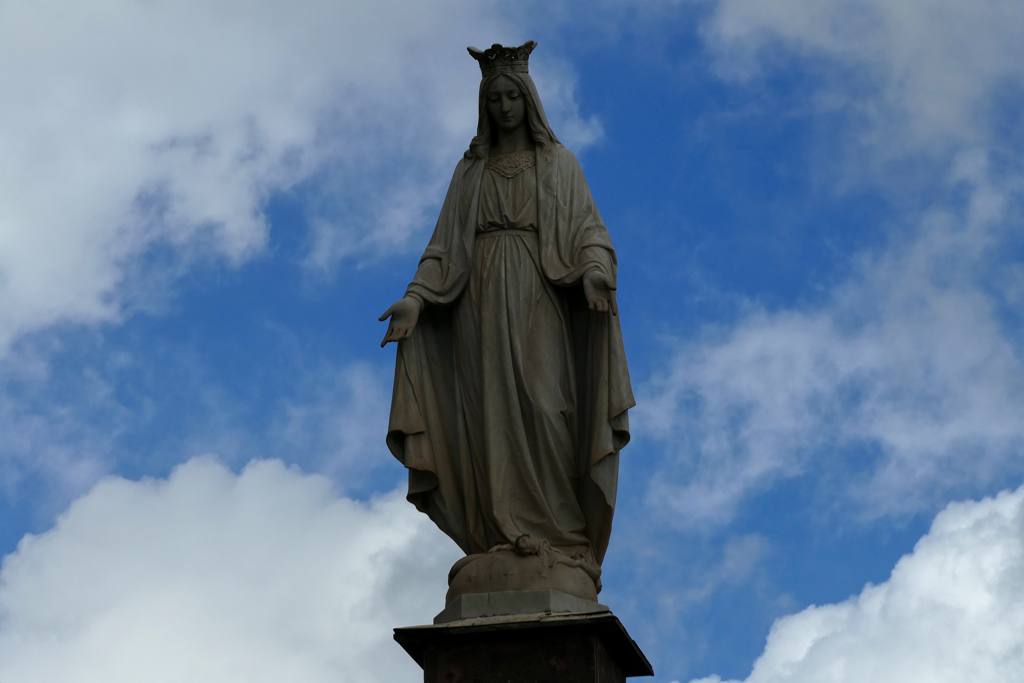
Also, the Plaza de San Cristóbal is better known as Plaza de La Milagrosa. This refers to the sculpture of the Virgen de la Milagrosa, obviously. This lady is made from Genoese marble and was brought to the city in 1929. After an unsuccessful attempt to place her on the façade of the church of San Agustin, they finally put her on an 8-meter-high pedestal in the square in 1960.
As a matter of fact, I’d recommend coming to this square if you want to get away from the tourist crowds in the historic old town. On Plaza de San Cristóbal, you’ll definitely rather rub shoulders with locals and can peacefully hang out on one of the benches or the terrace of one of the cafés.
Convento de Santo Domingo and Iglesia de Santo Domingo de Guzmán
As I finally wanted to see the places everyone was raving about, I walked up Calle Santo Domingo towards the iconic Plaza del Adelantado. But first I passed other interesting buildings that are rather neglected by the tourist crowds.
Nevertheless, the Iglesia de Santo Domingo de Guzmán is definitely one of the most important houses of worship in the city. It was built in 1527, hence five years after the construction of the adjacent Dominican Convent. It houses the portrait of the Virgin of the Candelaria, one of the most revered images of La Laguna. After all, she’s the Patron Saint of the Canary Islands.

In 1747, the famous corsair Amaro Rodríguez Felipe, more commonly known as Amaro Pargo, was buried in this church. Said Corsair, born in La Laguna in the vicinity of the Plaza de San Cristóbal that I’ve introduced above, was a patron of this temple. His marble tombstone stands just next to the church entrance.
Plaza del Adelantado
Now, as I finally made it to the Plaza del Adelantado, the serious sightseeing began.
Just kidding, however, since the square is located on the easternmost tip of La Laguna’s old town, it is a perfect starting point for a walking tour of the city. It has been the city’s most important square since Alonso Fernández de Lugo installed his residence here. He had founded the city in 1496 and since he went by the nickname El Adelantado, the square was named after him. His mansion stood where today the Santa Catalina Convent is located. Also, all important administrations were in the area.
Until the 19th century, many events like festivals, processions, bullfights, but also public punishment took place in this square.

The square’s shape was not as regular as it is today. Although its dimensions didn’t change, its appearance differs significantly. The square was only paved in 1798. In 1843, trees and benches were added. The central marble fountain was imported from Marseille in 1870.
This is My Spot
You’ll notice that some of the benches in the square are made of wood and others of stone. In colonial times, there was a rigid difference between social classes. Only the nobles and rich residents were allowed to sit on the wooden benches. Simple folks had to sit on the hard and most importantly cold stone benches.

On the eastern side of the square is the small chapel of San Miguel. It was built by Alonso Fernández de Lugo as a family mausoleum but was never used for that purpose. Instead, it served as the assembly hall of Tenerife’s island council. Today, it is an exhibition venue.
Casa del Santo Padre Anchieta
On the southern side of the square is the Casa del Santo Padre Anchieta. This building was constructed in the 16th century. The main façade faces Plaza Adelantado and shows features that are typical for Canarian architecture like symmetrical lines, and windows and doors set in stone.
Although it has now been confirmed that this is not the house where the missionary, Jesuit, and linguist José de Anchieta was born, he did live here for the first fourteen years of his life. He was mainly in charge of the Christianization of Brazil and was one of the founders of the city of São Paulo.
Antiguo Colegio de Las Dominicas
Now, let’s turn left into Calle Consistorio just really quickly. Here, the former school of the Dominican nuns is part of a complex of various historical buildings. It was built as a school building for Dominican nuns in the 18th century. Nevertheless, the architect used also elements from the late Middle Ages, such as pointed arches, ornamental gables, and pseudo-pinnacles. His idea was to tie in with the tradition of the monastery schools. For the same reason, there’s a statue of Saint Dominic attached to the southern end of the façade.

Today, this unique house is part of the town hall complex and houses the city archives.
Palacio de Nava y Grimón
Back to the Plaza del Adelantado, take a closer look at the Palacio de Nava y Grimón on the northwestern corner of the square. It actually has two amazing façades. The main one is facing the square while the lateral one is around the corner on Calle Deán Palahi.

This palace is an example of grand Canarian architecture that combines baroque, neoclassical, and mannerist elements. This mixture results from the different phases of construction over two centuries.
Construction began in 1585. In the mid-17th century, the first modifications took place. Finally, Tomás de Nava y Grimón y Porlier commissioned complete remodeling in 1776. The result is what you see today.
Convento de Santa Catalina
The convent actually occupies an entire block. In 1600, Juan de Cabrejas, governor of the island of La Palma, and his wife Doña María de Salas bought the land of Adelantado’s former estate. Eventually, they gave it to the Dominican Order to establish a convent. Also, a single-nave church was built at the same time as the monastery.

In 1611, the first four nuns moved in from Seville. Over the centuries, an entire complex of buildings was added to the convent. At the end of the 17th century, more than 100 nuns lived here. To this date, nuns of the Dominican Order live at the Convento de Santa Catalina.
Casa de Los Corregidores
As you walk down the Calle Obispo Rey Redondo – also called Calle La Carrera – towards the core of the historic center, you’ll pass a row of stately buildings to your left.
The first one is the Casa de Los Corregidores. It was completed in 1545 and owes its name to the fact that in ye olden days, it was the residence of the bailiffs.
The portal made of red stone is the only original part of the building. It consists of two parts surrounded by a flat frame.
Casa De La Alhóndiga
Next to the Casa del Corregidor is the Casa De La Alhóndiga which was completed in 1709. The portal consists of a large gate bordered by millstones. Above is the coat of arms of the Spanish Kings of the House of Borbón.
The large sliding windows are all of the same sizes and arranged symmetrically. The original façade was remodeled in the neoclassical style in the 19th century. In 1850, the city intended to open a theater at the Casa De La Alhóndiga. However, for economic reasons, this never happened.
From the Casa De La Alhóndiga, various economic activities of the island were managed and supervised. From the earliest times, it was the city council’s warehouse storing wheat’n’wine. Also, the poorest citizens got some wheat – no, not weed – here in times of deficiency.
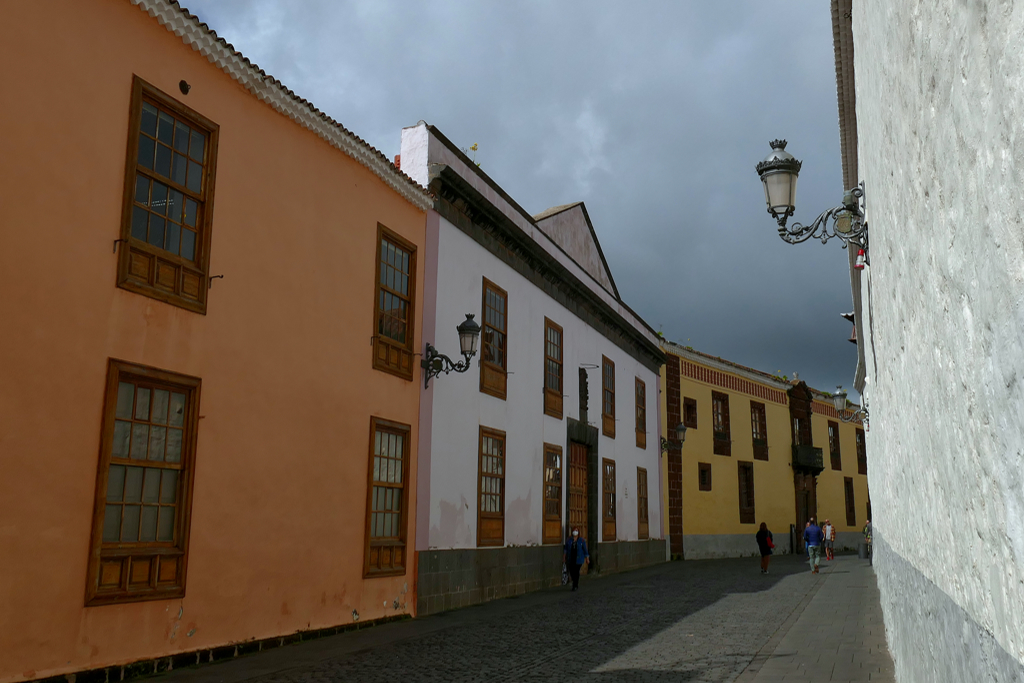
In 1809, 200 French men were imprisoned at the Casa De La Alhóndiga. They had been captured on the Spanish mainland during the Napoleonic invasion and deported from Cádiz to the Canary Islands.
Later, the mansion served as a Civil Guard lodging, as a barrack for a machine gun company, a hospital isolation ward during the Spanish flu of 1918, a municipal school, and a teacher training college.
Today, the Casa De La Alhóndiga houses offices of the city administration.
Casa Alvarado Bracamonte
So you think that the Casa De La Alhóndiga looks back at a crazily everchanging history? Well, its neighbor, the Casa Alvarado Bracamonte, does not stand far behind.

In 1624, Diego de Alvarado y Bracamonte became the governor and supreme commander of the islands of Tenerife in San Cristóbal de La Laguna. He married María de Vergara y Grimón, who brought a remarkable dowry into the marriage. Part of it was a piece of land on Calle Carrera where the couple had a house built for them. Eventually, their son Diego Alvarado y Bracamonte y Vergara y Grimón inherited the building. After he left for the Spanish mainland, the city’s Capitanes Generales resided in the mansion until 1723.

Only at the end of the 19th century, the owners sold the building to the brothers Antonio and José Leal y Leal who had moved to La Laguna from Cuba. Shortly after the city acquired the building. Today, it is part of the town hall complex.
Casa Van Den Heede
As you walk up at the next corner three blocks northwards, you’ll get to the Calle San Agustín where you can admire the highest number of stately buildings stemming from La Laguna’s gilded ages.

Despite its bright yellow color and the contrasting dark wooden windows and doors, the Casa Van Den Heede is often overlooked. In 1725, the Dutch merchant Guillermo Van den Heede commissioned this mansion. Among his descendants was the honorable Guillermo José Domingo Van den Heede Yansen Verschüeren Dujardin y Mesa, founding member of the Real Sociedad Económica de Amigos del País de Tenerife that I’m introducing below.
What you don’t assume from seeing the façade is that the building has one of the most interesting local interiors with no less than 38 rooms, a mezzanine, storage space on the top floor, a mezzanine, and an elegant courtyard.
Casa Montañés
The glory continues right at the next corner where Francisco Montañés had built a mansion in 1746. He was active in American trade, which to my knowledge never was a nice’n’noble activity.
It has three floors and a mezzanine where the business premises were installed. On the ground floor were the warehouse and wine cellar while the top floor served as a granary.
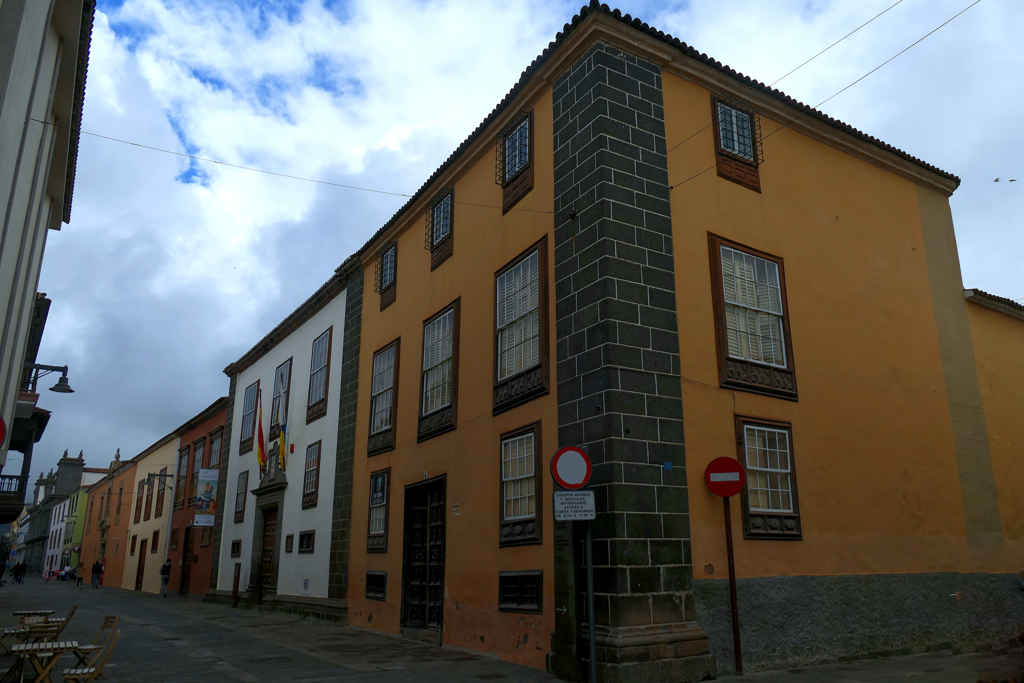
In 1985, the government of the Canary Islands acquired the building. It was then renovated and is today the seat of the Consejo Consultativo de Canarias, the Assembly of the Canary Islands.
Casa Lercaro
Just a few steps down the road is the Casa Lercaro. Built in 1593, it is a great example of the architecture of a Canarian mansion at the end of the 16th century. However, commissioner Francisco Lercaro de León actually came from an old Genoese merchant family. His ideas regarding architecture and lifestyle had a strong impact on the house’s appearance, obviously.
As very common in La Laguna, the façade is a plastered wall of natural stone, decorated with ashlars at the corners. The portal, however, is beautifully carved. Sgraffito in the fashion of Genoese palaces embellished the walls. Parts were uncovered and restored in the process of renovation.

Over the centuries, the building was used by the military, it was the seat of the philosophical faculty of La Laguna’s university, as well as an elementary school.
In 1976, the Cabildo de Tenerife acquired the property. Today, it houses the Museo de Historia de Tenerife.
The museum is open from Monday to Saturday between 9 a.m. and 7 p.m. and Sundays from 10 a.m. to 5 p.m. The general entrance fee is 5 €uros.
Real Sociedad Económica de Amigos del País de Tenerife
As I mentioned above, the Real Sociedad Económica de Amigos del País de Tenerife is an economic and cultural institution founded under the protection of King Carlos III of Spain in 1777. Its main objective is the development and promotion of literary, scientific, and artistic heritage in the Canary Islands

Its current headquarters are in the former Jesuit house from 1733.
Palacio Salazar
The Palacio Salazar is an excellent example of Canarian baroque architecture. Commissioned by Don Cristóbal Salazar de Frías, the palace was completed in 1687. In 1892, it became the seat of the bishop and the episcopal administration.

As you take a good look at the façade, it won’t surprise you that Andrés Rodríguez Bello created this palace. After all, he also designed the Palacio Nava y Grimón, and the similarities are obvious.
The most striking part is the pediment with the coat of arms of the Salazar family. At the edge of the roof are zoomorphic gargoyles.
A fire damaged the building severely in 2006, yet it was thoroughly restored.
Casa Museo Cayetano Gómez Felipe
At this former family residence of the collector Cayetano Gómez Felipe, you get a great impression of the life and belongings of a Canarian family since the 16th century.
The collection consists of paintings, sculptures, glass, furniture, fabrics, clothing, jewelry, photographs, documents, and much more. They give you a great insight into life on the Canaries throughout their history. After all, today’s tourist destinations were an important link between places along the commercial routes between the continents. Sadly, this included some rather dark aspects.
Iglesia de la Inmaculada Concepción de la Virgen María
Dark aspects of history – that brings us to the oldest parish church on the entire island. The first construction dates back to 1496. However, today, nothing remains of the original building as it was rebuilt in 1558.
Over the centuries, various parts were added, renovated, or even demolished. This was necessary because of the sometimes dangerously poor quality of the building materials used.
Consequently, the church is an assembly of structures from different eras and distinctive styles. However, the design that is typical for Canarian churches remains. There are stones at the corners, window panels, portals, as well as plastered and painted façades.

The church houses a baptismal font from Seville. It was supposedly used to baptize the Guanche princes who surrendered to the Spanish conquerors in 1496.
The belfry was first constructed in 1577. Since it soon collapsed, it had to be rebuilt in 1630. Yet, as this construction did not last very long, the tower was built a third and final time in 1694.
No matter what, I dare you would like to inform you that you can climb up the tower for a panoramic view. Visiting hours of the church are Tuesday through Friday from 10 a.m. to 5 p.m., Saturdays only till 2 p.m. To go up the tower, you have to pay 1 €uro.
Teatro Leal
The newest building in the series of the most interesting sights in La Laguna’s old town is the Teatro Leal. It was built in 1915 and stands out for its extraordinary façade as it shows characteristics of eclecticism.
After the theater had been used as a cinema In the 1960s, in 1990 it was closed for renovations. Only after 18 years, it reopened in October 2008 in the presence of Spain’s King Felipe VI and Queen Letizia.
Iglesia Catedral Nuestra Señora de los Remedios
Construction of La Laguna’s cathedral began in 1515. During the following remodelings, it was changed from a single-nave church into a three-nave church. In the 17th century, further chapels were added. At the end of the 18th century, the church consisted of five naves and a bell tower with a clock.
This bell tower had to be replaced at the beginning of the 19th century due to the danger of collapsing – what is it with those belfries in La Laguna?! On this occasion, they redesigned the entire façade. As this transformation coincided with the founding of the Diocese of San Cristóbal de La Laguna, the parish church became a cathedral.

Due to the many alterations even of the bearing structures, the building was so unstable that it had to be demolished. The only feature they kept was the façade. The rest was rebuilt in a neo-Gothic style.
Howsoever, you can visit the cathedral from Monday to Friday between 9 a.m. and 6.30 p.m., Saturdays only until 12.30 p.m. The general entrance fee is 6 €uros which includes an audio guide.
Urban Art in La Laguna
If you are a regular reader of my blog, you know that I’m a huge fan of urban art. I even have a whole section where I’m raving about great street art in many cities worldwide such as Berlin, Rio de Janeiro, and George Town. As you can read for instance in my posts on Málaga and Valencia, I’ve spotted some of the best pieces in Spanish metropolises. So if you are into urban art, you should definitely check them out.
Like everyone else, I came to La Laguna for the historic old core in the first place. However, as I walked from the main bus station toward the city center, there was some powerful street art that amazed me right away.
Only later did I learn about the awesome urban art projects in Calle Malpei and Muros Libres.
As far as I know, there were two editions of the Calle Malpei project, the first in 2017 and the second one in 2018. These led to seven large murals. The videos created for the festival are part of the festival project and they present the evolution of the project while the soundtracks have been originally and exclusively created by local artists.
Muros Libres
Artist Erik Air and city developer Ayoze Álvarez initiated another urban art project called Muros Libres, hence, free or empty walls, in 2017. It has been running now for many years as it grants urban artists the opportunity to practice their trade legally. Anyone who follows a few basic rules can decorate designated walls around the city. While this also restrains vandalism, it most importantly facilitates a vivid urban art culture.

So yes, these are the reasons why you’ll find an astonishing number of truly artistic and powerful murals in a small cozy place like San Cristobal de La Laguna.
fEO fliP
fEO fliP’s larger-than-life piece 1496 was the first mural I spotted walking down Avenida Trinidad. On the one hand, this arterial road is rather unappealing. But on the other hand, the huge bland walls of the prefab houses are great canvases for urban artists, obviously.

For the street art project, the city also commissioned its superstar muralist fEO fliP, obviously. Actually, after more than 17 years of painting in the streets, this was his first large-scale mural in the city where he was born.
His masterpiece depicts the conquest of Tenerife, the faith of the Guanche People, and other historical events of his home island.
Víctor Seus
Also the Canarian artist and political activist Víctor Seus contributed a powerful mural dealing with the culture and heritage of Tenerife.

Just like Matías Mata whom I’m introducing below, Seus studied Fine Arts in La Laguna. He got the Seneca and Erasmus mobility scholarships to study in Granada and Lisbon, respectively, before he graduated in 2009.
Víctor Sues still lives in Tenerife. I already introduced one of his murals in the urban art section in my post on Puerto de la Cruz.
4CON aka ACON
Now, this is a toughie since, despite extended online research, I wasn’t able to find info on this artist. Even his Facebook page and his Instagram account – which I’m linking below together with the accounts of all the other artists that I’m featuring in this post – do not reveal much about him.

All I can say is that his work is clearly inspired by Latin American ornamentation, color schemes, and motifs.
If anyone finds out more about 4CON aka ACON, please write it in the comment section.
Matías Mata aka Sabotaje al Montaje
Matías Mata was born on the Canarian island of Lanzarote. He has been spraying walls on the various Canarian Islands, on the Spanish peninsula, as well as in many countries around the globe. He started his career as an illegal sprayer. Yet, due to his indisputably outstanding talent as an artist, he’s now legally embellishing ugly buildings in dreary city areas.
After having completed two training courses in the graphic and technical fields, he studied fine arts at the University of San Cristobal de La Laguna.
As he created one of my very favorite murals as part of the Calle Malpei project, I chose to feature it as the header picture of this post, obviously. Also, I’m introducing his works in my posts on Morro Jable in the South of Fuerteventura, Santa Brigida on the island of Gran Canaria where he painted the Casa del Vino, on Puerto de la Cruz as well as on Santa Cruz de Tenerife.
Unknown Artist
Just around the corner from 4CON’s mural is a small dead-end alley. Here you’ll see many great murals and graffiti dealing with feminist topics. They are especially related to female migrants.

One of the most powerful pieces deals with the Marcha por la Libertad del Pueblo Saharaui, the freedom march for Sahrawi aka West Sahara. I don’t know if you are familiar with the conflict between Morocco and the neighboring West Sahara. Either way, the topic is far too complex to be dealt with in a touristy post like mine. If you want to learn about it, please do your own research. For those who can read Spanish, I recommend the page marchasaharaui.org.
Erik Air
Erik Verstraete is an artist whose graffiti career began in 2004. He lives in Tenerife and works there under the pseudonym Erik Air. Together with Ayoze Álvarez, he founded the urban art project Muros Libres in La Laguna in 2017. Since then he has also organized conferences and round table talks, promoting graffiti and urban art in the Canary Islands.

Since 2020, he has worked as a professional artist in a company specializing in murals, Mural Basement. His aim is to create quality murals, obviously. However, he’s also keen on creating jobs within this often belittled field.
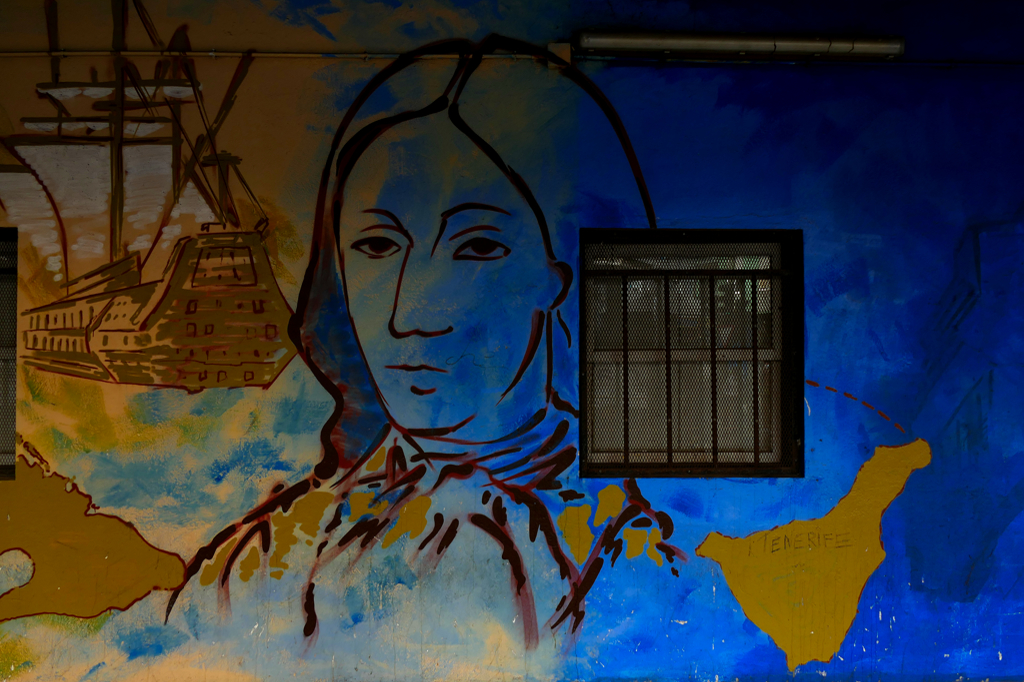
Not all of Erik Air’s works are part of the Muros Libres project. His mural at the arcade in Calle Barcelona celebrates the 18th anniversary of the designation of La Laguna’s old town as a World Heritage Site. It depicts historic moments, iconic buildings, and unique traditions.

Tanausú Aleman – Oscar Lorenzo – Iker Muro
While you might miss out on the larger-than-life murals on Calle Trinidad if you are coming to La Laguna by car, you’ll definitely notice the series of paintings next to the Plaza del Adelantado. Very different motives are embellishing an ugly wall right next to the spacious parking lot northeast of the square.

Three artists contributed different scenes of La Laguna to the compilation Domingo en La Laguna, hence, Sunday in La Laguna.

The best-known of the trio is probably Iker Muro aka MurOne. You’ll find his graphic pieces in bold colors in various places on Tenerife. One of his most prominent murals is in Santa Cruz de Tenerife where he collaborated with Louis Lambert aka 3ttman.
Although I’m not absolutely sure, I assume that Tanausú Alemán painted the two pieces above. They clearly show his iconic style. Tanausú Alemán is a muralist, illustrator, and teacher at a secondary school in Santa Cruz de Tenerife.
The third one is Óscar Lorenzo, a graphic designer, and illustrator by trade and an independent artist by heart. However, you’ll notice immediately that he has a solid academic background. Many of his works actually remind me of the Dada movement in the early 20th century. In graffiti, he creates mostly amazing lettering.
On Instagram
Just like in my former posts on urban artists, I’m listing their Instagram accounts below:
| feoFlip | @oakoak_street_art/ |
| 4CON | @4c0n_/ |
| Matías Mata | @sabotajealmontaje/ |
| Víctor Seus | @social_shaker/ |
| Erik Air | @erik_air/ |
| Tanausú Aleman | @tanausua/ |
| Oscar Lorenzo | @oscar__lorenzo/ |
| Iker Muro | @mur0ne/ |
| Muros Libres | @muroslibresproject/ |
Anaga Natural Reserve – A Visit To An Enchanted Forest
I had heard a lot of good things about La Laguna, but I had heard equally great things about the Anaga forest, hence, I divided this day trip into two parts.
That the skies over La Laguna got cloudy and then brightened up again every couple of minutes was annoying enough. Now, going into a forest was on a whole different level. But I was already in the area and had plans for the rest of my stay in Tenerife, so I gave it a shot. Maybe I’d be lucky and the almighty sun would chase those nasty clouds away and it would be a bright shiny day and once in the forest, I would run into a unicorn.
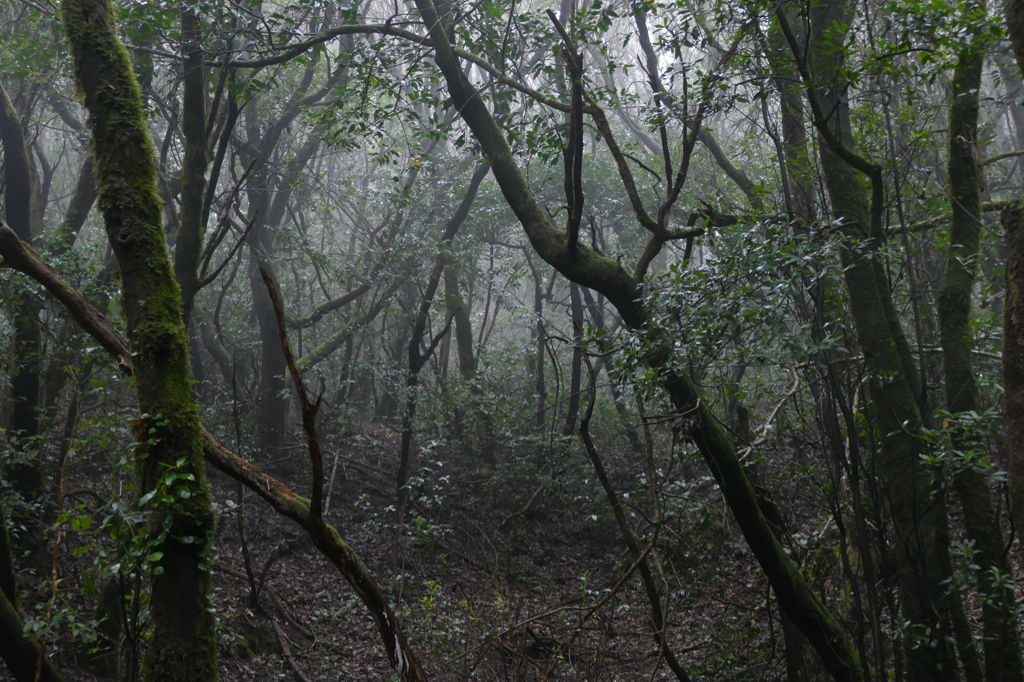
Well, as I finally sat on bus #275 which worked its way uphill into the nature reserve, the sky opened, and down came a gush of rainwater. It basically drowned the bus so that we weren’t even able to look out of the windows. Hence, we looked at each other. And our looks were not exactly happy.
Singin’ in the Rain
Do you know this phenomenon that when a heavy rain gets lighter, you have the impression it’s just a drizzle so that you are willing to go on? And once you start walking you realize that the rain is milder, but it’s raining just the same. Only that by that time, you are already soaked. Did that also happen to you? Well, maybe it’s just me since I’m so impatient that I walk out as soon as the weather changes from flood to simple rain.
Howsoever, that’s what it was like by the time we reached one of the reserve’s central points, Cruz del Carmen. By no means had the rain stopped. It just didn’t feel so hopeless anymore since it didn’t come down in cascades.

I got very clear and comprehensive instructions from one of the rangers on duty on how to walk route #2 and then I ventured out into the forest. Still hoped the rain would stop, the sky would open, and a unicorn would cross my way. None of this happened. And yet, it was a beautiful walk. Notwithstanding the fact that I lost my way despite the comprehensive instructions and therefore missed a major part of trail #2. But I didn’t really mind since it was still raining. By the time I made it back to the bus stop, I was pretty much soaked.
Anaga Natural Reserve
From La Laguna, it takes just about half an hour by public bus to get to the truly amazing Anaga Natural Reserve. But even if you are coming from Santa Cruz de Tenerife, you’ll get there via La Laguna in a bit over an hour.
The reserve spreads over an area of over 14,000 hectares over a mountain range in the extreme northeast of the island.
The sight of the mountain range is as beautiful as the views of the deep valleys and gorges stretching from the summit to the coast. There they end in secluded beaches where you can take a refreshing dip.

The best way to enjoy the Anaga Natural Reserve is to walk along the many hiking trails, obviously. The trees that are forming some kind of tunnels, the moss covering them and hanging from their branches, the bizarre formations of rocks under a sea of clouds – all this gives you the feel of walking through an enchanted forest.
Tenerife’s Wonderland
In the highest areas, you will find the most beautiful laurel trees in all of Tenerife. It is actually a relic from 40 million years ago. As a matter of fact, this type of forest covered the Mediterranean until the last Ice Age. Hence, walking between these twisted moss-covered trunks is a journey back in time.

Not only are the mountains one of the oldest geological formations in Tenerife. Due to distinct altitudes, microclimates, and soils, they facilitate the growth of exceptional biological diversity in a relatively small area. Therefore, you’ll find almost all of the island’s ecosystems here.

But not just the flora, the fauna is rich and diverse, too. You will find about a hundred unique animal species. Obviously, I’m not talking about lions and giraffes but rather about invertebrates and birds. The Anaga Natural Reserve is actually a special bird protection area. But as the reserve does not consist only of mountains, there is also a rich aquatic life.
There are also 26 small towns and hamlets in the area with a total of 2000 inhabitants. These people live mainly off small farms.
Plan Your Visit
The best way to plan your visit is by inquiring at the Cruz del Carmen Visitor Center. It’s a convenient place whether you come here by bus or by car. Not only is the bus stop just a few steps away. There is also a parking lot.
Just tell the rangers at the visitors’ center what you’d like to do. There are circular trails from 5 to 20 kilometers which equals around 1.5 to 8 hours. Also, be aware that not all hikes are of the same difficulty level. The best way is to just tell the guys how long you want to walk and how difficult the trail can be. Then, they show you one of the routes that might suit you best on a screen. Also, they give you a leaflet and off you go into the fairytale forest.

By the way, I chose #3 called El Bosque de Los Enigmas, hence, the forest of mysteries. You walk an easy route of 5 kilometers and can learn a lot about the mysteries of nature around you. The trail also passes by the Mirador de Zapata – and if you are lucky, you actually have a panoramic view.
The visitors’ center is open from Monday to Sunday between 9.30 a.m. and 4 p.m.
Also, there are several specially protected areas within the park. If you want to get to know them, you need to contact the Department of Environmental Protection either by phone at +34-922-84 30 97 or by email at coordinacionmam@tenerife.es to inquire about the access conditions.
What to Bring
Everything depends on the activities you have planned. What’s definitely indispensable is a pair of good hiking shoes. You might hike some of the easier trails in sneakers. But after I broke my leg in a gorge in Gran Canaria, I’m an ardent advocate of sturdy footwear with a firm grip.
Also, you should always have your cell phone on you and check the connection from time to time.
If you are hiking in summer, you should have sunscreen on you and wear a hat. However, up here, the weather can change unexpectedly quickly. Therefore, bring at least a rain skin, better a foldable rain jacket as it can get also a bit nippy.
Even on the shorter hikes, you should always have some drinking water on you and possibly some fast snacks like protein bars or sundries.
If you choose a hike that passes or ends at one of the stunning coves, you should definitely bring your bathing suit. After a hike, nothing beats a refreshing dip in the ocean.
To enjoy the reserve from the early morning or until late, you might want to consider spending a night at the Albergue Montes de Anaga* hostel. It is located in El Bailadero right on the ridge of the mountains. It offers every comfort and is also just a stone’s throw from the best beaches in the area.
How to Get to San Cristobal de La Laguna
As I pointed out, La Laguna is just a very short bus drive from Puerto de la Cruz. Busses #102 and #103 are taking you to the Intercambiador, the main bus station, in 35 to 45 minutes. If you are coming from Santa Cruz de Tenerife, you have tons of options to get to La Laguna by bus.
TITSA, Tenerife’s local bus company, has a great website where you’ll find all the connections and prices, and everything you need for an easy trip. There is even a section that’s especially catering to tourists.
As there are many more connections to the different towns around the island, make sure to check out TITSA‘s website. However, to learn about the island’s bus system and the different ticket options, you can also go to my general post on Tenerife.
La Laguna’s main bus station is called Intercambiador and, just like on the other islands, locals call buses la guagua.

There are two tram lines called Tranvia de Tenerife. They connect the main places of interest between Santa Cruz and La Laguna. A general single ticket costs 1.35 €uros. You’ll find all information including various ticket options on Metrotenerife’s website.
My tip:
Tenerife’s bus system is great, however, buses between popular spots’n’towns tend to get really, really packed. I witnessed people standing on the bus for an entire one-hour ride or even being left behind at the station. Therefore, always take the bus at its starting point. For instance, as you are going from La Laguna to Puerto de la Cruz, there is another bus stop called Leocadio Machado. But since it is the next stop after the Intercambiador, the buses tend to be packed to the brim by the time they get there. Therefore, it’s definitely worth the 10-minute walk from the bus stop to the main bus station to catch the bus there.
Also, don’t come waltzing to the stop three minutes before the scheduled departure. If you are riding the bus on popular routes, make sure to be at the stop at least 15 minutes before departure time. Normally, there is a queue, hence, don’t just linger at the station but get in line as soon as you can.
Feliz viaje!
How to Get to Anaga Natural Reserve
Although it’s such a dreamy and secluded place, getting to the Anaga Natural Reserve is fairly easy even if you don’t have your own vehicle.
Coming from La Laguna, you can take one of the following lines: #76, #77, #271, #274, or #275. However, if you want to go to the forest from the historic center, it’s better to take one of the buses at the bus stop Marcos Redondo northwest of the old town. You’ll see the stop on the map below.
Going to Anaga’s Mirador Cruz del Carmen from Santa Cruz de Tenerife, take any bus going to La Laguna and change to one of the above-mentioned lines. Note that there are two direct buses, #945 and #947, going from Santa Cruz to the Natural Reserve. Bus #947 takes you to El Bailadero where you can spend the night at the hostel Albergue Montes de Anaga*. However, the direct buses from Santa Cruz do not stop at the Cruz del Carmen info center but go up the coast to the eastern part of the Anaga Natural Reserve.
Where to Stay
I’d argue that San Cristobal de La Laguna can be an excellent base for a stay in Tenerife, especially if you have your own car. But even if you depend on the local system of public transportation, you should be fine. I’ve introduced the connections above.
No, you won’t be next right to the beaches but you’ll certainly cherish the beauty and peace of a Canarian small town once the day trippers leave in the afternoon.
Hence, take part in everyday life in La Laguna and book your accommodation right in the historic city center. For example, if you stay at the La Laguna Gran Hotel* or the Hotel Aguere*, you’ll experience the charm of a traditional colonial building.
On the map below, you can check out some unique lodging options around San Cristobal de La Laguna*:
Booking.comNow, to enjoy the serene surroundings at the Anaga Natural Reserve, I recommend spending the night at the hostel Albergue Montes de Anaga* in the quaint town of El Bailadero. It’s in the reserve’s east, quite far towards the coast. You have to take bus #947 at the Intercambiador of Santa Cruz de Tenerife to get there. The ride takes about 1.5 hours.
Well-Organized Activities
Although it’s very easy to get to La Laguna, you might want to combine a visit with other places like for instance the Anaga Natural Reserve. Especially if you don’t have enough time to explore each spot on a half-day trip, an organized tour of various places is a great alternative.
Therefore, here are some great ideas on how to visit some of the most intriguing places on the island of Tenerife*:
The visit to San Cristobal de La Laguna and the National Park Anaga was just one of the amazing day trips during my week in Tenerife. To read about the others, go to this post and take your pick!
For general information on Spain, go to this post since there, you’ll find information and tips that will make your trip much smoother and more enjoyable.
Map
This map will help you to find all the mesmerizing places in San Cristobal de La Laguna. Clicking on the slider symbol at the top left or the full-screen icon at the top right will display the whole map including the legend.
Pinnable Pictures
If you choose to pin this post for later, please use one of these pictures:



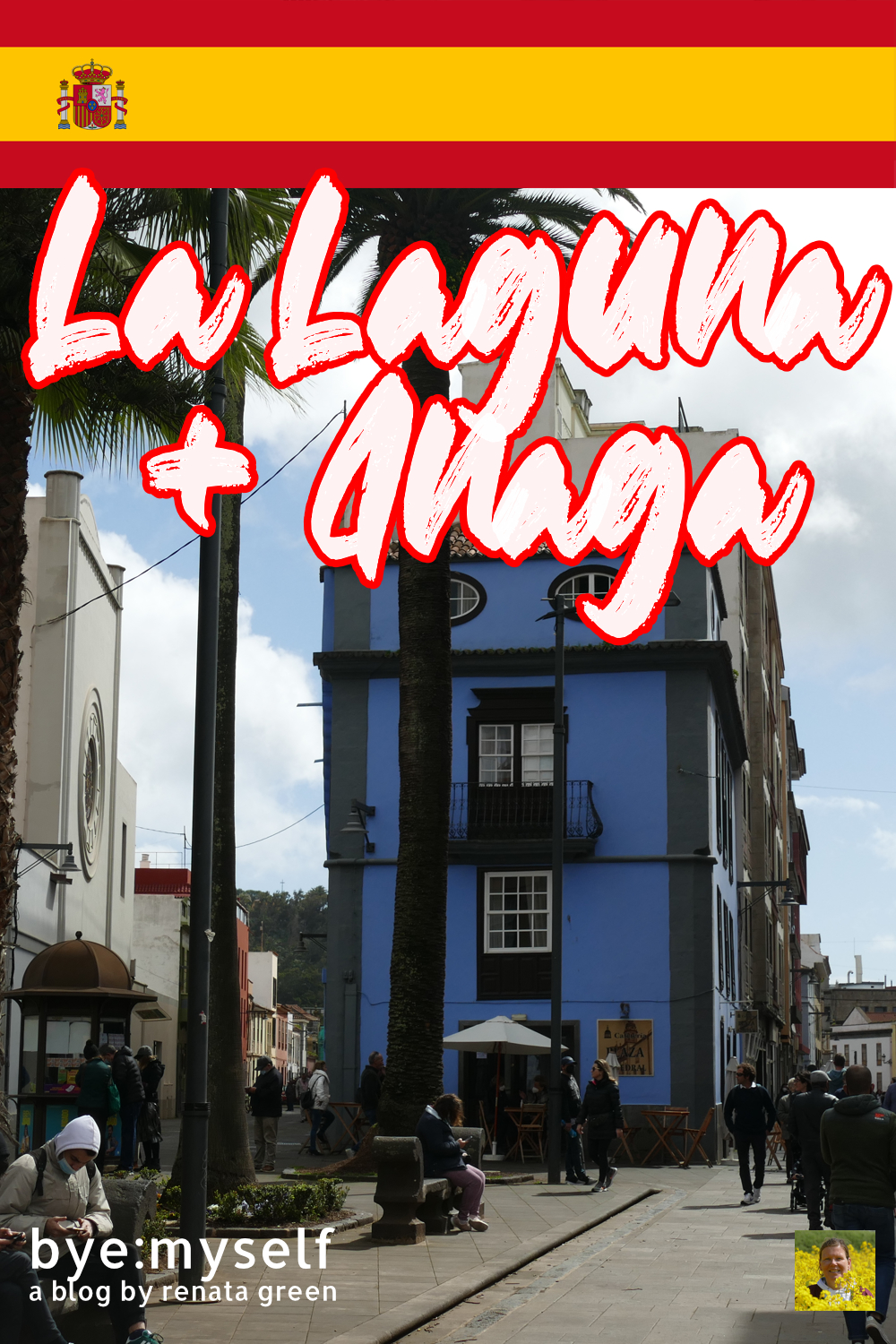


Note: I’m completing, editing, and updating this post regularly – last in January 2024.
Did You Enjoy This Post? Then You Might Like Also These:
Day Trip to San Cristobal de La Laguna and the National Park of Anaga
LA OLIVA – Fuerteventura Like in Ye Olden Days
One Day in SANTA CRUZ de TENERIFE
Break a Leg – My Bumpy First Encounter With Gran Canaria
CANDELARIA, Home of the Canarian Virgin Mary and the Guanches
PUERTO del ROSARIO – Fuerteventura’s Underrated Capital
LA GOMERA – How to Explore the Canaries’ Ravishing Wild Child by Public Bus
ARTENARA and TEJEDA – a Day Trip to Gran Canaria’s Highest and Most Beautiful Villages
* This is an affiliate link. Hence, If you book through this page, not only do you get the best deal. I also get a small commission that helps me run this blog. Thank you so much for supporting me!
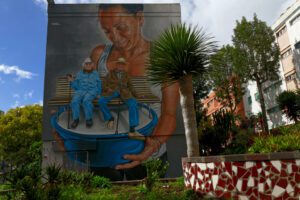


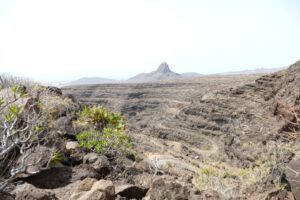




I missed La Laguna and Anaga when I visited Tenerife! The Murals are awesome. The artists must be very talented to draw such giant paintings and get the expressions and colors of people in the murals so right! Yes, we depend on the weather wherever we travel and cross our fingers that it does not rain. I love your introductory paragraph! 🙂
Great that you did not let less than ideal weather stop you from heading out. And you got an ok day for exploring San Cristobal de La Laguna. I love towns like this that you can wander. What a great walk though the history of the town you got. And you saw an interesting array out outdoor art. I always love how much I learn about the pieces and artists when I read your posts. I might pass on a visit to the Anaga Natural Reserve if the weather turned. But I can see why you visited.
Glad to be able to still inspire an avid traveller like you 😉
Your post brought back memories of my visit to San Cristobal de la Laguna. Like you, I tremendously enjoyed walking the cobbled streets and looking at the colonial houses. We also spend the night there. As most visitors come only for a day trip, the atmosphere in the evening was more local. Thanks for the street art guide – this is something to be explored when/ if I visit a second time.
It’s so interesting to read more about Tenerife other than the beaches and nightlife here. I had no idea these places in La Laguna and Anaga existed, or the history. The urban art is fantastic and so expressive too!
As a matter of fact, the really great parts of Tenerife are still a bit hidden – and soooo worth being explored!